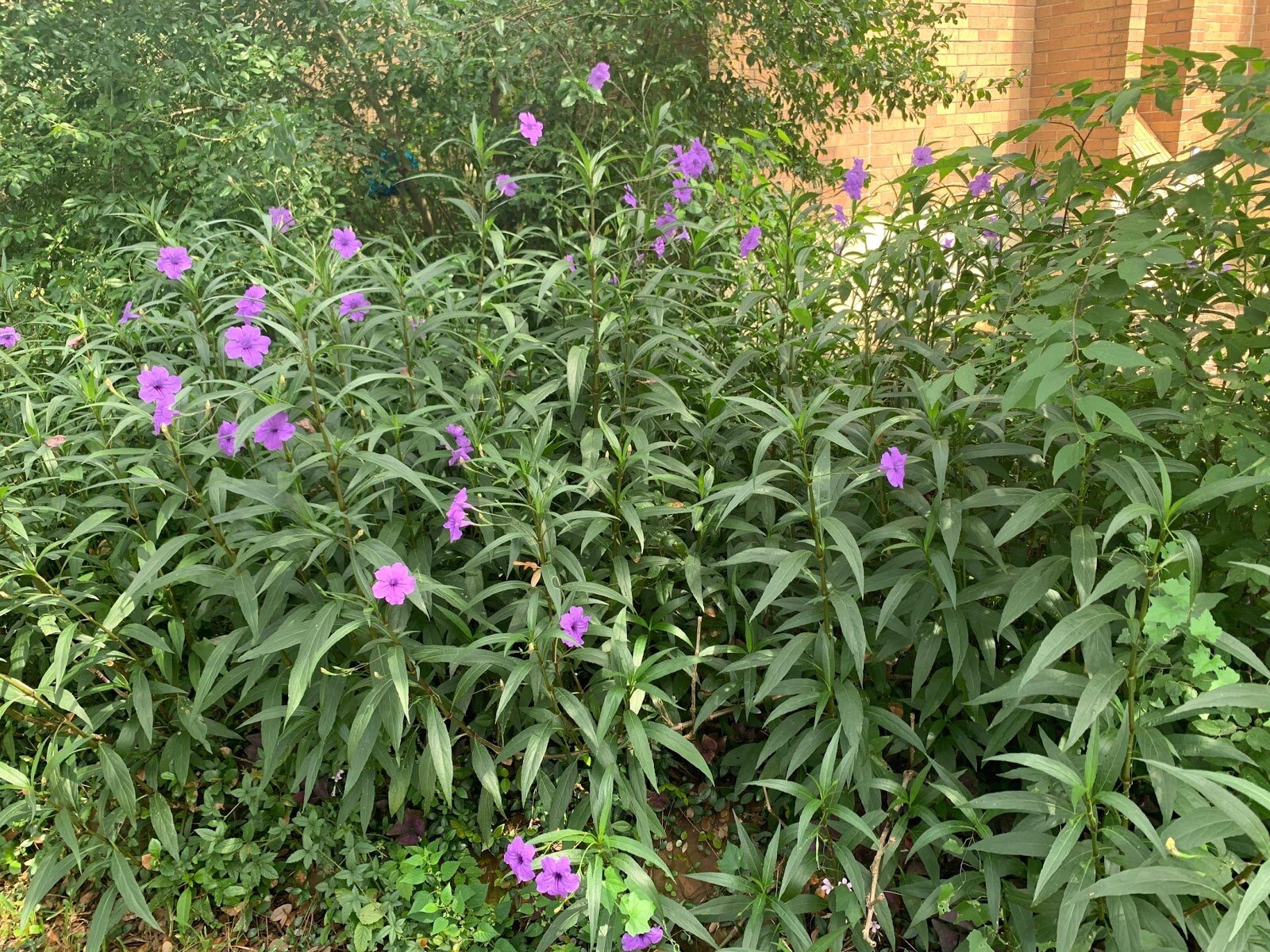Ruellia simplex, Mexican Petunia
/By: Joey Messina
Mexican Petunia plant. Photo by Joey Messina.
Mexican Petunia inflorescence. Photo by Joey Messina.
Mexican petunia or Ruellia simplex is a perennial evergreen that is also referred to as Ruellia brittoniana; however, Ruellia simplex, was the name given when it was first discovered in Cuba. There are a few common names as well as different cultivars. The common names include: Brittons wild petunia, Mexican bluebell and Texas petunia (NC State, Ruellia Simplex). The different cultivars include: ‘ChiChi’, ’Katie’, and ‘Purple Showers’. The more common cultivar would be ‘Katie’ which is to be considered as a “dwarf” and only grow up to less than a foot tall.
Mexican petunias are a part of the Acanthaceae family and considered a shrub. Mexican petunias usually grow to the max height of around 2-3 feet high and 24-36 inches wide when planted in a garden. However, in the wild they can reach up to 4 in a half foot tall. Mexican petunias were first brought to Florida in the early 1940s.
When it comes to choosing a landscape plant, one consideration to take is if the plant is invasive. With that being said, Ruellia is considered invasive to the state of Florida for many reasons. They invade natural areas, and they can grow well in hot and humid or hot and dry environments. Although they are native to Mexico and South America, they can be mainly found in landscapes in Hawaii, Texas, and the southern states.
Once the plant has officially rooted, they are pretty much tolerant of drought. Mexican petunias need full sun or partial shade to reach their max growth environment; however, they require full sunlight to bloom their beautiful purple and white flowers. These plants require medium amounts of water to keep the soil damp. These plants can be relatively easy to overwater (coming from a personal experience). Mexican petunias are perennials in zones 8–11 (Missouri Botanical Garden).
Lanceolate leaf shape Mexican Petunia. Photo by Joey Messina
The leaves are simple, lanced-shaped, and oppositely arranged. The leaves can grow up to twelve inches long and up to three quarters of an inch wide. The leaves have very veiny patterns on the underside of them. Mexican petunias have a purple trumpet-shaped flower and can produce flowers from May through November. Mexican petunias produce dehiscence seed pods or capsules containing up to 30 seeds. Those 30 seeds are then released up to a ten-foot in diameter and can germinate very easily. These seeds can sprout almost any time of the year except when the temperature drops drastically. Mexican petunias can also self-propagate by spreading new plants from the roots and can get out of control when left alone. They can also be propagated by cutting the stem under the node and placing it into moist soil or by taking a piece of the root from the original plant (NC State, Ruellia Simplex).
Mexican petunias are used frequently in southern landscapes because they are very easy to grow, do not need a lot of attention and they are beautiful when they flower. The most common uses in the landscape for Mexican petunias are using them as a border in a bed where larger shrubs are growing behind them. Ruellia simplex is not common for landscape borders because they are the wild cultivar, fertile, and also can start to grow out of hand. If Mexican - petunia is not completely removed, it will continue to resprout (Center for aquatic and invasive plants, 2020). The best use for Ruellia simplex would be to place into a pot and leave out in the sun in order to avoid rapid spreading of the plant. Ruellia simplex does not hold really any industry value because they can rapidly produce and are not ideal for modern landscapes. However, the fruitless varieties are going up in value due to the astonishing look they portray in modern landscapes. This plant can be useful in horticulture because of its distinct flower color as well as how simple it is to grow.
Center for Aquatic and Invasive Plants. (2020, October 6). | Center for Aquatic and Invasive Plants: University of Florida, IFAS. Retrieved September 13, 2020, from https://plants.ifas.ufl.edu/plant-directory/ruellia-simplex/
Missouri Botanical Garden. (n.d.). Ruellia simplex 'Purple Showers'. Retrieved September 13, 2020, from https://www.missouribotanicalgarden.org/PlantFinder/PlantFinderDetails.aspx?kempercode=c952
NC State. (n.d.). Ruellia simplex. Retrieved September 13, 2020, from https://plants.ces.ncsu.edu/plants/ruellia-simplex/





